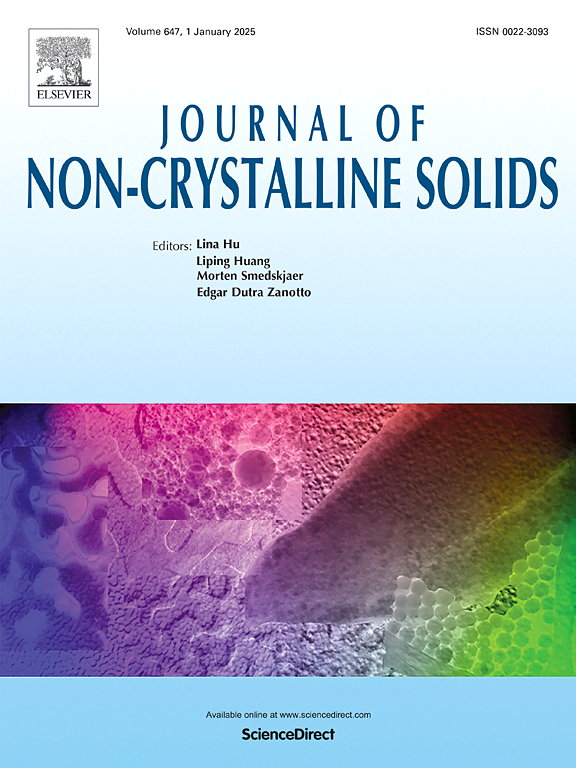High-temperature stability of aluminosilicate glass particle pellets and its dependence on chemical composition
IF 3.2
3区 材料科学
Q1 MATERIALS SCIENCE, CERAMICS
引用次数: 0
Abstract
Mineral wool, especially stone wool, is a sustainable, fire-safe insulation material. Its fire safety depends, amongst other factors, on its high-temperature stability (HTS), that is, its resistance to volumetric shrinking during heating. Using glass particle pellets as an analogue for mineral wool fibres, we observed a positive correlation between particle size and HTS, as well as between particle size and crystallisation temperatures, and an inverse correlation between particle size and the degree of iron oxidation upon heating. To investigate the composition dependence of HTS, we prepared two series of aluminosilicate glass particle pellets: one with varying MgO/(MgO+CaO) molar ratio (referred to as the CaO-MgO series) and another with varying MgO/(MgO+FeO) molar ratio (referred to as the FeO-MgO series). The results showed that substituting MgO for CaO resulted in decreased glass stability, a lowered onset temperature of shrinking, a reduced shrinking rate, and an increased HTS. In comparison, substituting MgO for FeO led to increased glass stability, an increased shrinking rate, and a decreased HTS. Crystallisation occurs right after the glass transition for the FeO-rich FeO-MgO samples and MgO-rich CaO-MgO samples, but a residual glassy phase remains. Upon further heating, the residual glassy phase undergoes viscous deformation, leading to a significantly reduced temperature of the final collapse of the glass particle pellets. This work provides a facile and efficient approach to studying the HTS of glass particle pellets as an analogue for mineral wool fibres.
铝硅酸盐玻璃颗粒球团的高温稳定性及其对化学成分的依赖性
矿棉,尤其是石棉,是一种可持续的防火保温材料。除其他因素外,其防火安全性取决于其高温稳定性(HTS),即在加热过程中对体积收缩的抵抗力。使用玻璃颗粒颗粒作为矿棉纤维的类似物,我们观察到颗粒大小和高温高温之间呈正相关关系,以及颗粒大小和结晶温度之间的正相关关系,以及颗粒大小和加热时铁氧化程度之间的负相关关系。为了研究HTS的组分依赖性,我们制备了两个系列的铝硅酸盐玻璃颗粒:一个是改变MgO/(MgO+CaO)摩尔比的(称为CaO-MgO系列),另一个是改变MgO/(MgO+FeO)摩尔比的(称为FeO-MgO系列)。结果表明,MgO取代CaO降低了玻璃稳定性,降低了收缩起始温度,降低了收缩速率,提高了高温超导温度。相比之下,用MgO代替FeO可以提高玻璃稳定性,提高收缩速率,降低高温超导温度。富feo的FeO-MgO样品和富mgo的CaO-MgO样品在玻璃化转变后立即发生结晶,但残余的玻璃相仍然存在。在进一步加热后,残余的玻璃相发生粘性变形,导致玻璃颗粒颗粒最终崩溃的温度显著降低。这项工作提供了一种简单而有效的方法来研究玻璃颗粒颗粒作为矿棉纤维的类似物的高温超导。
本文章由计算机程序翻译,如有差异,请以英文原文为准。
求助全文
约1分钟内获得全文
求助全文
来源期刊

Journal of Non-crystalline Solids
工程技术-材料科学:硅酸盐
CiteScore
6.50
自引率
11.40%
发文量
576
审稿时长
35 days
期刊介绍:
The Journal of Non-Crystalline Solids publishes review articles, research papers, and Letters to the Editor on amorphous and glassy materials, including inorganic, organic, polymeric, hybrid and metallic systems. Papers on partially glassy materials, such as glass-ceramics and glass-matrix composites, and papers involving the liquid state are also included in so far as the properties of the liquid are relevant for the formation of the solid.
In all cases the papers must demonstrate both novelty and importance to the field, by way of significant advances in understanding or application of non-crystalline solids; in the case of Letters, a compelling case must also be made for expedited handling.
 求助内容:
求助内容: 应助结果提醒方式:
应助结果提醒方式:


